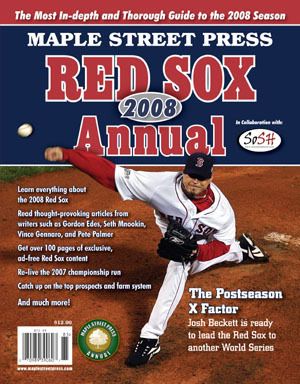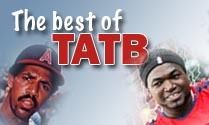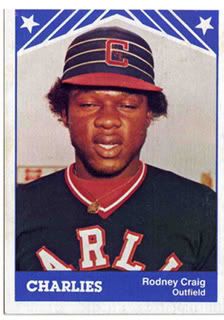I love the '80s

Wade Boggs and Ryne Sandberg were elected to the Baseball Hall of Fame today, putting both men among company they deserve to keep. They are worthy choices, and in the case of Sandberg, the finest second baseman of his era, it was an honor a few years overdue.
Which comes as no surprise, really. For some inexplicable reason, so many great players from the '80s are getting little or no love from the Hall of Fame voters. Oh, sure, the no-brainers got in with proper ease: George Brett, Nolan Ryan, Mike Schmidt, Eddie Murray, Tito Landrum . . . you know, the obvious ones. But so many truly wonderful players from that era are having a hard time getting due respect from the voters, at least in their early years on the ballot
I have my theory why the decade is generally disregarded: the inflated statistics (and inflated biceps and inflated foreheads) of this generation have made the more modest numbers of their predecessors look less impressive than they actually are. So many of these guys were true superstars, the best of their time. But their stats don't look so super stacked up against the bloated numbers of the current time.
It's hard to believe now in this era of Monster Mashers, but no player hit 50 homers between 1977 (when George Foster hit 52) to 1991 (when Cecil Fielder hit 51). Hell, the AL's leading home run hitter in 1989 was Fred McGriff . . . with 36. Three years later, the Crime Dog led the league again . . . with 35. Not even Tom Emanski would be impressed with those digits.
Still, such uniform disrespect for an entire era of ballplayers is not right. On a day when Boggs and Sandberg - two genuine greats - got their just rewards, it seems appropriate to praise a few of their peers who are also deserving of the game's highest honor. So then, permit me to suggest half-dozen or so stars from the last generation who would have been on this fan's Hall of Fame ballot, along with their years in the big leagues and the number of votes that they were shy of the 387 required for induction:
Huh? What's that? Tito Landrum isn't in yet? Cripes, these Hall voters really don't know what their doing . . .
Goose Gossage (1972-94), 102 votes short: In my 26 years as a baseball obsessive, there have been precisely two closers who kidnapped your hope of victory the moment they stepped out of the bullpen. Mariano Rivera, pre-October 2004, is one. The great Goose is the other. He has the stats (310 saves, a 3.01 ERA, 9 All-Star appearances), the longevity (23 seasons) and a certain flair (gotta dig the fu-manchu, the raging-stork follow through, and that Yaz-killing rising fastball that always seemed on the verge of spontaneous combustion). The Goose? C'mon, people. He was automatic as a closer, and he damn sure should be automatic for the Cooperstown, too.
Jim Rice (1974-1989), 80 short: Rice was the most feared power hitter in the American League from 1977 to 1986 - in other words, an entire decade. He won three home run titles, led the league in total bases four times (including an astounding 406 in his MVP season of 1978), and finished in the top 5 of the MVP voting five straight years. So why hasn't the Hall called? Because, ironically enough, while he was dominant for an extended period, he never quite managed to be mediocre in the twilight of his career. Rice's final three seasons went thusly:
1987: .277-13-62
1988: .264-15-72
1989: .234-3-28
And then he was done, at age 36, with 382 homers and a .298 average, numbers just shy of crucial Hall of Fame milestones. Had he been able to hang on for three or four more years, hitting around .280 with 18-20 homers and padding his stats to proper levels, he'd have long ago been enshrined. Rice's vote totals were up this year, and with a Hall class next year headed by guys who were mediocre forever (Gary Gaetti, anyone?), hopefully he'll get that phone call that's already long overdue.
Which brings us to The Hawk . . .

Andre Dawson (1976-95), 117 short: Stood alongside Hall of Famer Dave Winfield as the best all-around player in baseball in the early- and mid-80s, a power-speed-defense combo with a nickname that perfectly captured his graceful yet almost fierce fly-chasing style in centerfield. Unfortunately, his glory days game in the obscure baseball outpost of Montreal, and by the time his travels took him to larger markets (Chicago, where he won the '87 NL MVP, and Boston, where he didn't win much of anything) he was declining into a one-dimensional slugger whose knees had long since been turned into Steak-'Ems by Olympic Stadium's unforgiving AstroTurf. But with 438 homers, 314 steals and 20 seasons of dignity and class, he gets my vote every time. Let the The Hawk in, dammit.
Alan Trammell/Lou Whitaker, (1977-96, 1977-95), 300 short/off the ballot: Ask me, these guys are damn near Hall-worthy based on their individual merits. Trammell was the true MVP of the 1987 season (criminally awarded to Toronto DH/Mutt George Bell), hitting .343 with 28 homers and 105 RBI while playing a brilliant shortstop for the AL East champs. It was his best season among many. He finished in the top three of the MVP voting three times, was the MVP of the 1984 World Series, and along with Cal Ripken Jr. and Robin Yount, were the prototypes for Garciaparras, Jeters and Tejadas, the great field/great hit shortstops of today. As for Whitaker, he made five All-Star teams, won the 1978 AL Rookie of the Year award, bashed 244 homers (how he loved that short rightfield porch in Tiger Stadium) and won three Gold Gloves. According to baseball-reference.com, the most similar player to Whitaker in history is Sandberg, with Trammell second. Decent company there. But while they were excellent individually, their legacy is and will always be as a tandem. Trammell and Whitaker. Whitaker and Trammell. They debuted together on Sept. 9, 1977, and for the next decade and a half, they became perhaps the finest long-running double-play combination in the game's history. It's apparent they aren't getting into Cooperstown individually, not with Whitaker getting bounced from the ballot in his first year of eligibility. Perhaps they could share a plaque. It's unprecedented and unlikely, sure. But how appropriate it would be.

Jack Morris (1977-1994), 215 short: Decent farm system the Tigers had there from '76-'78, huh? In a ridiculously fruitful three-year stretch, Detroit developed Mark Fidrych, Jason Thompson, Steve Kemp, Lance Parrish, Whitaker, Trammell and Morris. Of the latter trio, Morris is the most likely to eventually make it to Cooperstown. In fact, we are so certain he will get there that we already have a pretty good idea of what it will say on his Hall of Fame plaque:
Morris, a pockmarked, mustached righthander, was considered the finest big-game pitcher of his era. In Game 7 of the 1991 World Series, the slider specialist pitched 10 shutout innings in the Twins' 1-0 victory over the Atlanta Braves, ranking among the greatest clutch pitching performances in postseason annals. Pitched a no-hitter during the Tigers' 35-5 start in 1984 on the way to a World Championship. Finished in the top ten in Cy Young voting six times, led the American League in victories twice, and spewed one of the sport's most memorable quotes when he said, upon spying a female reporter in the locker room, "The only time I want to be talking to a woman naked is when I'm on top of her or she's on top of me." Jack Morris, Mr. Class.
Steve Garvey (1969-87), 281 short: When Garvey was active, it was assumed that he was a Hall of Famer. Maybe the reason that he hasn't has a sniff of Cooperstown is that he's been a little too active in retirement, having apparently sired half of Orange County. His "Mr. Dodger" reputation has been revealed as cultivated, if not fraudelent, a trait that tends to piss off the press, which hates to be played for the fool. His cumulative statistics may not appear entirely Hall-worthy - a .296 average, 2,599 hits, 272 homers - but his resume includes a lenghthy column of impressive secondary credentials, such as an NL-record consecutive games streak (1,207), four Gold Gloves, one MVP award (1974), and 11 postseason appearances, in which he batted .339 with 11 homers in 55 games. Should he be in? I'll leave it at this. Garvey may not be a Hall of Fame cinch, but he was far more accomplished than Tony Perez, Cooperstown Class of 2000.
Otis Nixon (1983-99), 387 short: Nope, not a single vote for Otis My Man. Not a shock, just a damn shame. Ask me, there should be a place in some Hall of Fame somewhere for a man who looked 65 when he was 25, who, five years after leaving behind his already dim big-league spotlight was charged with trying to stab his bodyguard (wait . . . he has a bodyguard?), who married Sugar Ray Leonard's ex-wife and later traded up for one-time pop-tart Pebbles, who inexplicably bunted into the final out of the 1992 World Series, who, during his fledgling days with the Indians, surely inspired the legendary movie character Willie Mays Hayes, and who, most memorably to my own eyes, walked down the main street of Old Orchard Beach, Me. on a sweltering summer day in 1984 wearing his trademark Jheri curl and a leather pants-and-vest outfit that surely had to have been discarded by the Jackson brothers during their Victory Tour. Trust me, it's an image you don't forget. Never will there be another one like Otis. He deserved a vote for originality alone. Besides, wouldn't you love to see this face on a plaque?














|
<< Home